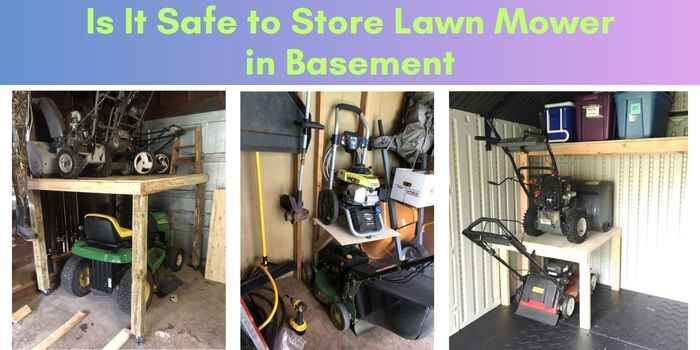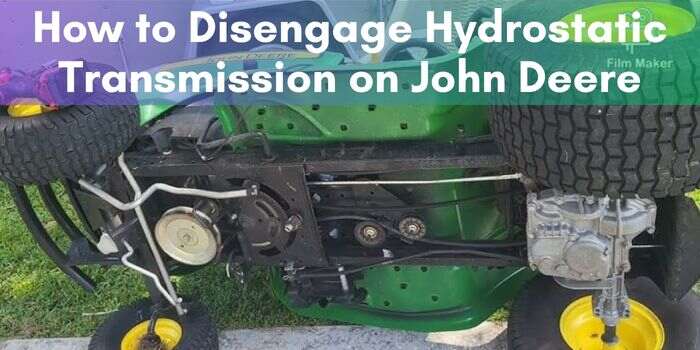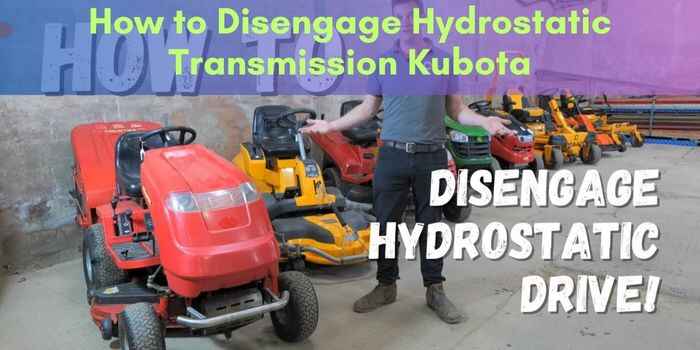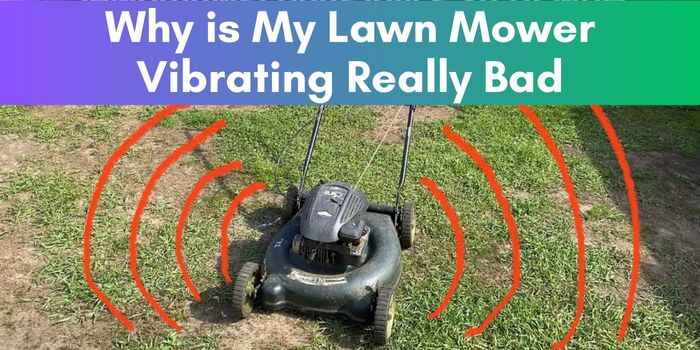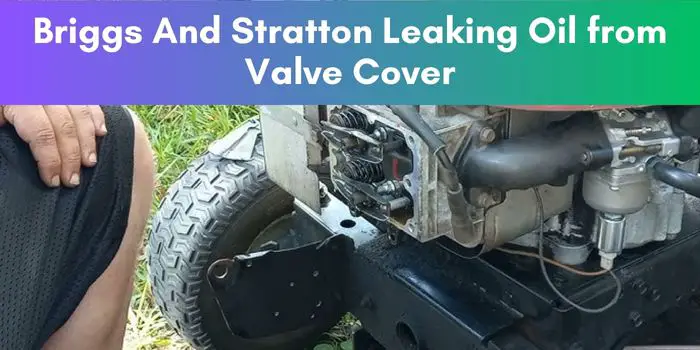How to Disengage Hydrostatic Transmission Cub Cadet: Easy Push & Maintenance Guide
To disengage the hydrostatic transmission on a Cub Cadet, locate the control lever on the right side of the unit near the seat and move it to the neutral position. This will release the tension and allow the transmission to disengage.
In addition, ensure that the parking brake is engaged for safety purposes. Disengaging the hydrostatic transmission is a straightforward process that can be done quickly and easily, allowing you to operate the Cub Cadet without the transmission engaged.
Keep reading for a step-by-step guide on how to disengage the hydrostatic transmission on your Cub Cadet.
Understanding The Basics: What Is A Hydrostatic Transmission?
A hydrostatic transmission, also known as a hydrostatic drive, is a type of transmission used in Cub Cadet machines. It is a fluid-based system that uses hydraulic power to transfer energy from the engine to the wheels, allowing for seamless control of speed and power.
Unlike traditional transmissions that use gears, a hydrostatic transmission utilizes a combination of hydraulic pumps and motors to deliver power to the wheels.
Hydrostatic transmissions are commonly found in a variety of Cub Cadet machines, including lawn tractors, garden tractors, and zero-turn mowers.
This type of transmission is particularly well-suited for these applications due to its ability to provide precise control and smooth operation.
Signs Of Engagement Issues
Signs of Hydrostatic Transmission Engagement Issues:
If you’re having trouble disengaging the transmission or your mower seems to be moving even with the levers in the neutral position, there might be an engagement issue. Here are some signs to watch out for:
- Mower Moves in Neutral: If the mower continues to move even when the hydrostatic levers are in neutral, it indicates a problem with the bypass valve or linkage.
- Difficulty Disengaging: If you find it difficult to move the bypass valve control lever, it could be due to dirt, rust, or a bent linkage.
- Grinding Noises: Grinding noises while operating the hydrostatic levers can signify internal wear and tear within the transmission.
Common symptoms of a hydrostatic transmission that is not disengaging properly
When a hydrostatic transmission is not disengaging properly, there are several common symptoms that you may notice. These signs can help you recognize if your Cub Cadet is experiencing engagement issues:
- Fluid leaks: One of the most noticeable signs of engagement problems is the presence of fluid leaks. You may notice puddles or stains on the ground beneath your mower. It is crucial to address fluid leaks promptly, as they can lead to further damage and loss of functionality.
- Jerking movements: If you feel jerking movements or sudden changes in speed while operating your Cub Cadet, it is a clear indication that the hydrostatic transmission is not disengaging properly. These jerks can be jarring, affecting the quality of your mowing and potentially damaging the transmission system.
- Noise and grinding: A hydrostatic transmission that is not disengaging may also produce unusual noises, such as grinding or whining sounds. These noises indicate internal friction and may be a result of inadequate disengagement. Ignoring these sounds can lead to further damage to the transmission.
- Inconsistent operation: You may also notice inconsistent operation while using your Cub Cadet. The mower may not respond accurately to changes in speed or direction, making it challenging to mow efficiently. This inconsistency is a clear sign that the transmission is not disengaging as it should.
Step-By-Step Guide: Disengaging The Hydrostatic Transmission
Are you having trouble disengaging the hydrostatic transmission on your Cub Cadet? Don’t worry, we’ve got you covered with this step-by-step guide.
Disengaging the hydrostatic transmission is an important skill every Cub Cadet owner should know, as it allows you to safely perform maintenance or move the machine without the transmission engaged.
So, let’s dive into this guide and learn how to disengage the hydrostatic transmission on your Cub Cadet.
Preparing the Cub Cadet: Safety precautions and proper machine positioning
Before you begin disengaging the hydrostatic transmission, it’s crucial to take some safety precautions and position the machine correctly.
Here’s what you need to do:
- Make sure the Cub Cadet is on a level surface to prevent any accidents.
- Engage the parking brake to keep the machine from rolling.
- Turn off the engine and remove the key to eliminate any risk of accidental startup.
Locating the transmission lever or switch for disengaging
The next step is to identify the transmission lever or switch that allows you to disengage the hydrostatic transmission.
Depending on the model of your Cub Cadet, the location may vary. Refer to the owner’s manual or the manufacturer’s website to find the specific location for your machine.
Step 1: Releasing the parking brake for added safety
Before attempting to disengage the hydrostatic transmission, ensure that the parking brake is released. This extra safety measure prevents any accidental engagement during the process.
Step 2: Depressing the brake pedal or engaging the bypass valve
In order to disengage the hydrostatic transmission, you need to either depress the brake pedal or engage the bypass valve. This step may vary depending on the model of your Cub Cadet, so refer to the owner’s manual for the correct procedure.
Step 3: Adjusting the transmission lever or switch to disengage the transmission
Now it’s time to actually disengage the hydrostatic transmission. Locate the transmission lever or switch mentioned earlier and adjust it according to the manufacturer’s instructions. This action will disconnect the transmission, allowing you to perform maintenance or move the machine with ease.
Step 4: Verifying that the transmission is properly disengaged
Once you have adjusted the transmission lever or switch, it’s essential to verify that the hydrostatic transmission is properly disengaged. Take a moment to check for any signs that the transmission is still engaged, such as resistance or movement when attempting to move the machine.
Step 5: Resuming normal operation after disengagement
After you have confirmed that the hydrostatic transmission is disengaged, you can resume normal operation. Before doing so, double-check that all safety precautions are in place, including the parking brake, and ensure that you follow proper operating procedures as outlined in the owner’s manual.
Remember to always consult the owner’s manual or the manufacturer’s website for specific instructions related to your model.
Troubleshooting: Dealing With Common Disengagement Issues
When it comes to your Cub Cadet hydrostatic transmission, one of the most frustrating issues you may encounter is difficulty in disengaging it.
This can manifest in various ways, such as a stubborn engagement, grinding noises, or even transmission slipping.
Fortunately, these issues can often be resolved through some troubleshooting steps.
Addressing potential problems such as stubborn engagement, grinding noises, or transmission slipping
If you find that your hydrostatic transmission is not disengaging smoothly or is exhibiting any unusual symptoms like stubborn engagement, grinding noises, or transmission slipping, there are several possible culprits.
One of the common causes can be mechanical issues or maladjustment in the system. It is important to tackle these issues promptly to prevent further damage to your Cub Cadet.
Below are some steps you can take to address these problems:
- Check for any mechanical issues, such as worn-out components or loose connections. Examine the transmission belt, pulleys, and linkage for any signs of damage or wear.
- Adjust the linkage if necessary, ensuring it is properly aligned and tensioned. This step may require referencing your Cub Cadet manual for specific instructions on how to adjust the linkage correctly.
- Inspect the fluid level and condition of the hydrostatic transmission. Low fluid levels or dirty fluid can affect the performance and disengagement of the transmission. If the fluid level is low, top it up with the recommended fluid as per the manufacturer’s guidelines. Additionally, consider changing the fluid if it appears dirty or contaminated.
Consulting the Cub Cadet manual or seeking professional assistance
If you have followed the troubleshooting steps mentioned above and the disengagement issues persist, it may be time to consult the Cub Cadet manual or seek professional assistance.
The manual will provide you with detailed information and specific instructions related to your hydrostatic transmission.
Sometimes, more complex problems require expert diagnosis and repair, especially if you are not familiar with the inner workings of the transmission.
Remember, addressing disengagement issues promptly and correctly will help maintain the performance and longevity of your Cub Cadet hydrostatic transmission.
Maintenance Tips: Keeping Your Hydrostatic Transmission In Top Condition
The hydrostatic transmission is the heart of your zero-turn mower or lawn tractor, responsible for smooth and efficient operation. Proper maintenance extends its lifespan and ensures optimal performance.
Here are some key tips to keep your hydrostatic transmission in top condition:
Regular Fluid Checks and Changes:
- Check the fluid level: Refer to your owner’s manual for the recommended interval (usually every 25-50 operating hours) to check the hydrostatic transmission fluid level. Wipe the dipstick clean, insert it fully, then remove it again to check the fluid level. Ensure it falls within the designated range markings.
- Change the fluid: Consult your owner’s manual for the recommended fluid type and change intervals (typically every 100-200 operating hours). Draining the old fluid, replacing the filter, and refilling with fresh fluid removes contaminants that can cause wear and tear.
Maintaining Cleanliness:
- Keep it clean: A clean machine is a happy machine! Regularly remove dirt, grass clippings, and debris from around the transmission housing to prevent them from entering the system and causing damage.
Filters Matter:
- Replace the filter: The hydrostatic transmission filter plays a crucial role in trapping contaminants before they can harm internal components. Change the filter at the recommended interval specified in your owner’s manual, typically alongside a fluid change.
Leaks and Warning Signs:
- Be vigilant: Keep an eye out for any leaks around the transmission housing. Leaks indicate worn seals or loose connections and should be addressed promptly to prevent fluid loss and potential damage.
- Listen closely: Unusual noises like grinding or whining noises coming from the transmission can signal internal problems. If you hear anything out of the ordinary, stop using the mower and consult a qualified mechanic.
Proper Operation:
- Avoid overloading: Hydrostatic transmissions are designed for specific weight capacities. Avoid overloading your mower or tractor with excessive cargo or attachments, as this can put undue strain on the system.
- Engage and disengage smoothly: Don’t abruptly change direction or engage the mower deck while moving at high speeds. Apply gradual pressure on the controls to minimize stress on the transmission.
Lubricating moving parts and ensuring proper belt tension
Maintaining proper lubrication of the moving parts in your hydrostatic transmission is crucial for its optimal performance. Regularly inspect the transmission for any signs of wear or dryness, and apply the recommended lubricant if needed.
Another important aspect of maintenance is ensuring proper belt tension. Over time, the drive belt may become loose or worn, affecting the overall performance of the transmission. Refer to the owner’s manual for instructions on adjusting the belt tension or consult a professional if you are unsure.
Inspecting and replacing worn or damaged components
The hydrostatic transmission is the lifeblood of your Cub Cadet mower or tractor, ensuring efficient and trouble-free operation. Regular inspection and replacement of worn or damaged components within the transmission are crucial for maintaining optimal performance and preventing costly breakdowns.
Why Inspect Your Hydrostatic Transmission?
Just like any other machine component, parts within the hydrostatic transmission experience wear and tear over time. Left unchecked, these issues can lead to:
- Performance Decline: Worn components can decrease transmission efficiency, reducing power and responsiveness.
- Increased Fuel Consumption: A stressed transmission can lead to higher fuel consumption to maintain operation.
- Unexpected Failure: Worn parts are more prone to sudden failure, potentially leaving you stranded or causing safety hazards.
Regular Inspection for Early Detection
By incorporating regular inspections into your maintenance routine, you can identify and address minor problems before they snowball into major repairs. Here’s what to watch for:
- Visual Inspection: Look for leaks around the transmission housing, which can indicate worn seals or loose connections.
- Fluid Condition: Check the fluid level and condition according to your owner’s manual. Discolored or burnt-smelling fluid suggests overheating or internal wear.
- Unusual Noises: Pay attention for any grinding, whining, or clunking noises coming from the transmission while operating the mower.
Replacing Worn Components
If your inspection reveals worn or damaged parts, it’s crucial to replace them promptly. While some repairs might be manageable for DIY enthusiasts with mechanical knowledge, complex replacements are best left to qualified mechanics. Here’s a general overview of the replacement process:
- Consult Your Manual: Refer to your Cub Cadet owner’s manual for specific instructions on accessing and dismantling the hydrostatic transmission.
- Identify the Faulty Component: Common culprits include bearings, seals, filters, or drive belts. Ensure you have the exact replacement part for your model.
- Safety First: Disconnect the battery and drain any fluids before starting disassembly.
- Replace and Reassemble: Following the manual’s guide, carefully replace the worn component and reassemble the transmission.
- Proper Lubrication: Replenish the transmission fluid with the recommended type and quantity as specified in the manual.
- Test and Verify: Once reassembled, operate the mower and check for proper function. Ensure there are no leaks and the transmission operates smoothly.
Exploring aftermarket attachments and modifications for enhanced hydrostatic performance
If you’re looking to maximize the potential of your Cub Cadet hydrostatic transmission, aftermarket attachments and modifications can be a game-changer. These upgrades are designed to enhance the performance and capabilities of your machine, providing smoother operation and more efficient power delivery. Consider the following:
- Performance tires: Upgrading to high-traction tires can significantly improve the grip and maneuverability of your Cub Cadet, especially on uneven terrain.
- Weight distribution: Adding additional weights or counterweights to the front or rear of your machine can improve stability and balance, reducing the chances of wheel slippage.
- Suspension systems: Installing a suspension system can absorb shocks and vibrations, providing a smoother ride and reducing strain on the hydrostatic transmission.
Upgrading to high-performance hydraulic fluid or filters for improved longevity
The quality of the hydraulic fluid and filters in your Cub Cadet hydrostatic transmission can greatly impact its longevity and overall performance. Consider upgrading to high-performance options that are specifically designed to endure the demands of heavy-duty applications. Some benefits of these upgrades include:
- Improved lubrication: High-performance hydraulic fluids provide superior lubrication, reducing friction and wear on internal components.
- Enhanced heat resistance: Upgrading to fluids with better thermal stability can help prevent overheating, ensuring optimal performance even under extreme conditions.
- Superior filtration: High-quality hydraulic filters can effectively capture and remove contaminants, preventing them from damaging the transmission system.
Frequently Asked Questions
How Do You Put A Hydrostatic Lawn Mower In Neutral?
To put a hydrostatic lawn mower in neutral, locate the lever or button labeled “neutral” on the control panel. Push or slide it to disengage the drive, allowing the mower to move freely without power. Check the user manual for specific instructions for your model if needed.
What Happens If You Push A Hydrostatic Mower?
Pushing a hydrostatic mower can damage the transmission or engine. The mower is designed to be self-propelled, so pushing it may strain the internal components. It’s important to operate the mower as instructed to avoid costly repairs and maintain its optimal performance.
How Do You Get A Cub Cadet Zero Turn To Roll?
To get a Cub Cadet zero turn to roll, engage the parking brake, make sure the throttle is at the idle position, turn on the ignition key, and move the steering levers to the neutral position. Then, release the parking brake and slowly move the steering levers outward to start rolling.
Can You Push A Hydrostatic Mower?
Yes, you can push a hydrostatic mower if necessary. Hydrostatic mowers are designed to be operated by their engines, but they can be manually pushed when needed.
Conclusion
Disengaging the hydrostatic transmission on your Cub Cadet is a straightforward process that grants you the freedom to push the mower for maneuvering or maintenance tasks.
By following the steps outlined in this guide and consulting your owner’s manual for specifics, you can ensure a smooth disengagement process. Remember, a well-maintained hydrostatic transmission is vital for the efficient operation of your Cub Cadet.
If you experience any signs of engagement issues, don’t hesitate to seek help from a qualified technician to keep your mower running like new and your lawn looking lush. Now, get out there and enjoy a stress-free mowing experience!


